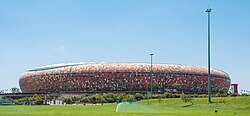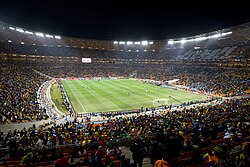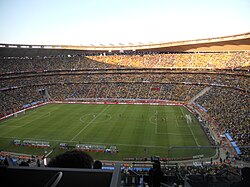Soccer City, The Calabash | |
 FNB Stadium | |
 Interactive map of First National Bank Stadium | |
| Full name | FNB Stadium |
|---|---|
| Former names | Soccer City (2010) |
| Address | Soccer City Ave Nasrec 2147 |
| Location | Johannesburg, South Africa |
| Coordinates | 26°14′05″S27°58′56″E / 26.23472°S 27.98222°E |
| Elevation | 1,753 m (5,751 ft) [1] |
| Owner | City of Johannesburg |
| Operator | Stadium Management South Africa |
| Executive suites | 195 |
| Capacity | 94,736 |
| Record attendance | 94,807 (Kaizer Chiefs vs Orlando Pirates, 1 August 2015) [2] [3] |
| Field size | 105 × 68 m |
| Surface | Grass |
| Construction | |
| Broke ground | 1986 |
| Built | 1987–1989 |
| Opened | 7 October 1989 |
| Renovated | 2007–2009 |
| Expanded | 2009 |
| Construction cost | ZAR 3.3 billion (US$440 million) |
| Architect | Boogertman & Partners, HOK Sport (now Populous) [4] |
| Builder | Grinaker-LTA/ BAM International |
| Structural engineer | Schlaich Bergermann & Partner |
| Tenants | |
| Kaizer Chiefs South Africa national football team South Africa national rugby union team | |
| Website | |
| www | |
First National Bank Stadium or simply FNB Stadium, also known as Soccer City and the Calabash, is an association football (soccer) and rugby union stadium located in Nasrec, bordering the Soweto area of Johannesburg, South Africa. The site is managed by Stadium Management South Africa (SMSA) [5] and is home of Kaizer Chiefs F.C. in the South African Premier Soccer League as well as the venue for key fixtures for the South Africa national football team.
Contents
- Naming history
- Construction
- Stadium design
- Before the upgrade
- Major tournaments
- 1996 African Cup of Nations
- 2010 FIFA World Cup
- 2013 African Cup of Nations
- Football
- International football
- Local football
- Rugby Union
- Concerts
- Christian gatherings
- Incidents
- Gallery
- See also
- References
- External links
It is located next to the South African Football Association headquarters (SAFA House) where both the FIFA offices and the Local Organising Committee for the 2010 FIFA World Cup are housed. [6] Designed as the main association football stadium for the 2010 World Cup, the FNB Stadium became the largest stadium in Africa with a capacity of 94,736. However, its maximum capacity during the 2010 FIFA World Cup was 84,490 due to reserved seating for the press and VIPs. The stadium is also known by its nickname "The Calabash" due to its resemblance to the African pot [7] or gourd.
It was the site of Nelson Mandela's first speech in Johannesburg after his release from prison in 1990, and served as the venue for a memorial service to him on 10 December 2013. [8] [9] It was also the site of the funeral of anti-apartheid activists Chris Hani (on 19 April 1993) and Oliver Tambo (on 2 May 1993). [8] It was also the venue for the 2010 FIFA World Cup Final, which was played by the Netherlands and Spain. The World Cup closing ceremony on the day of the final saw the final public appearance of Mandela. [10]








